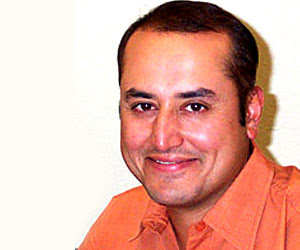 Ankit Fadia
Ankit FadiaThe following is a timeline of Ankit Fadia's "career", compiled using information in public sources such as news articles, his web sites and more. This will help explain how someone his age simply cannot be an "expert" by any commonly accepted meaning of the word. Such a timeline also better highlights contradictions and discrepancies he has told various reporters or published in his biographies.
1989 .. 2003 - Delhi Public School, India (2004 resume)
1995 May , 24 - Turned 10 years old.
* "gifted a PC" (indiaPRwire, thehindu), contradicts several other publications where he was quoted saying "gifted a PC at 12"
1997 May, 24 - Turned 12 years old.
* "gifted a PC" (rediff, SWG), contradicts several other publications where he was quoted saying "gifted a PC at 10"
* "developed interest in computer hacking" (indiaPRwire)
1998 May, 24 - Turned 13 years old.
* "wasted on playing games" (several sources)
* "developed interest in computer hacking" (SWG)
* "began writing a website on computer security and started his own Internet forum." (expressbuzz)
* "hacked front page of CHIP magazine" [reference], contradicts claim it was Indian .gov site
* "At the age of thirteen I performed my first hack and defaced the Indian government website." [reference], contradicts claim it was magazine site
1999 May, 24
- Turned 14 years old.
* "started my own web site" (rediff) [Archive], yet site says "Established: 16th February 2001"
* "published first book" (indiaPRwire, expressbuzz)
* "He claims that when he was 14, he trashed the front page of an Indian magazines website." [reference]
1999 June, 28 - Publishes "The Unofficial Guide To Ethical Hacking" (ISBN 0333 93679 5) at 628 pages in 15 days (rediff), yet asks simple questions that an author should know. Some biographies claimed it sold 500,000 copies and was translated into 11 languages.
2000 May, 24 - Turned 15 years old.
2001 - He claims that he discovered links between the Chinese government and the China Eagle Union, a cracker group responsible for defacing many U.S. web sites. [reference]
2001 May, 24 - Turned 16 years old.
2001 June 29
- Publishes guide to defacing web pages. [reference]. This can be easily argued that any claims of "ethical" hacking are invalid.
2001 Nov - "consulted by a classified intelligence agency for breaking an encrypted message sent by one of Osama Bin Laden's men (indiaPRwire) and "After the September 11 attacks, the U.S Government found some encrypted mails. The mails apparently had only pictures and no text accompanying them. “The pictures followed the steganography pattern where in photographs with embedded messages are used. I gave a few suggestions on decoding them." (thehindu.com) - The oOnly reference, other than Fadia, is reputedly from Jack Kelley of USA Today who was later fired for fabricating stories.
2002 Aug
- Moves personal site to ankitfadia.com.
2003
- Fadia's site, Ankitfadia.com, was attacked in 2003 by a cracker who self-identified as "SkriptKiddie". Fadia explained that he was using a private web server for hosting his website and they were responsible for the lack of security. [reference]
2003 Apr
- Several biographies claim he spoke at the "52nd International Programme on Auditing Information Technology" [reference]. However, no other mention of this conference can be found, and the liklihood of a 52 year old conference on auditing IT not being more well-known is hard to believe.
2004 May 24, Turned 19 years old.
2004
- Fadia's resume says that two of his books have sold a combined 87,000 copies. This contradicts some biographies that say it sold 500,000 copies.
2004
- Freshman at Stanford University (2004 resume)
2007
- Stanford University '07 Alum (facebook)
2008 May 24 Turned 23 years old.
2008 July 11
- First evidence his site http://hackingmobilephones/ hit by viagra spammers. [reference]
2008 Aug
- "consulted by the Navi Mumbai Police Department to trace the terror email sent just a few minutes before the Gujarat serial blasts" (indiaPRwire)
2008 Dec 16
* "author of 14 pubs" (indiaPRwire)
* "delivered more than 1000 talks in 25 countries" (indiaPRwire)
* "received 45 awards" (indiaPRwire)
* "senior at Stanford University" (indiaPRwire). This may contradict his claims of being "07 Alum" depending on use of word. While generally accepted this is used to mean "graduated", the technical definition includes "or student". However, why would he keep "'07 Alum" on his Facebook page that he actively updates in 2009?
2009 May 24 - Turned 24 years old.
2009 Nov
- "has a degree in information security from Stanford University in the US." (tech2.in.com). His Facebook page in 2009 says "Management Science and Engineering".
2009 Nov 24
- "[The Unofficial Guide to Ethical Hacking] became an international bestseller, sold over three million copies and was translated into 11 languages." [reference]
2009 Dec
- Public notices his site has viagra spam, yet Fadia didn't notice since July of 2008. [reference]
2009 Dec
- "The Unofficial Guide to Ethical Hacking has sold more than 7.5 million copies worldwide and is still counting." (rediff) This makes sales of the book over 4 million in a matter of months, or contradicts previous numbers.
2009 Dec 21
- According to his web site, "His books have sold a record 10 million copies across the globe".





